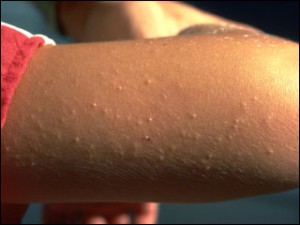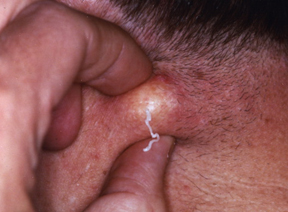Every now and again people will tell me that they have rough skin on the back of their upper arms, almost like little white or flesh toned bumps, that come and go and they don’t know what it is. Well, I’m here to tell you that it is super common and it is called Keratosis pilaris. And while it can be a little frustrating to treat because it can come and go, it is really common.
It is a skin condition that causes these patches of rough (can be dry-looking) skin, that may have bumps that look like very small acne and the bumps are usually found on the upper arms, thighs, and butt area. It can become inflamed or itchy at times, but it is not contagious, it doesn’t spread, and has no long-term health issues. It is just more annoying than anything else as it tends to go away (or even completely disappear) during the summer months and start to act back up in the fall/winter months.
What causes it?
Basically, it is a build-up of keratin, which is the hard protein in your skin that acts as a protectant. The extra keratin builds up and blocks the pores, causing these hard little bumps and when many of them form, it makes the skin rough and patchy, and appear bumpy. When your skin gets dry, the Keratosis pilaris tends to get worse, which is why it tends to act up during cold winter months, because our skin tends to be drier. There is no real reason why it occurs because it tends to occur on many different people and isn’t linked to any other particular disease process.
How do I diagnose and treat it?
The good news is that your HCP or your dermatologist can diagnose your Keratosis pilaris just by assessing your skin; there is no need to have blood drawn or be poked or prodded!! The treatments can be a little more annoying, but usually pretty easy and over the counter (OTC):
– Exfoliate: You can exfoliate your skin to keep those pores open and prevent them from being blocked by the keratin. You can also use medicated creams that help to soften and exfoliate the creams to alleviate the bumps. The best creams to use, contain: salicylic acid, urea, alpha-hydroxy, and/or lactic acid.
– Daily Moisturizer: keeping the skin moist by using lotion daily can help to keep the bumps from occurring, and also drying off after the shower by gently drying with your towel and not vigorously wiping the towel against your skin can also help you.
– Corticosteroids: OTC hydrocortisone creams can help with the irritation and itchiness that can occur, but should really only be used short-term to treat any irritating symptoms. It can alleviate those issues.
– Humidify: Keeping the air in your home moist with a humidifier can also keep your skin moist and prevent that dryness that can make the Keratosis pilaris act up.
– Retinoids: Topical medications that are Vitamin A derived (Retin A, and Tazorac) which are by prescription only, can help the cells to go through their life cycle faster, thus promoting new skin cells and decrease/prevent the clogging of the pores by the keratin. Retinoids can be a pain to get covered by insurance and require pre-approval by most insurance companies, but they are very helpful.
All of these treatments are really helpful while you use them, and can make the appearance of the Keratosis pilaris go away, but once you stop treating it, unfortunately the symptoms usually come right back and they can last for years. It cannot be prevented, it is just one of those things that happens to many people and for most people it gradually fades away and is gone by the time people are around 30 years old. Give these treatments a try, and talk to your HCP if they don’t work and see if there are other options for you.
Yours in Good Health
B






